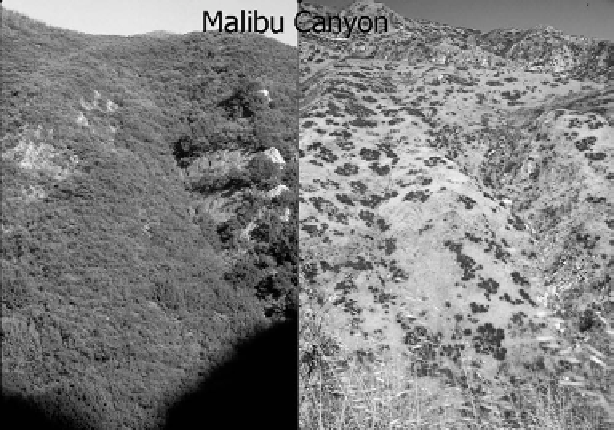Agriculture Reference
In-Depth Information
Fig. 12.2
Type conversion recorded for Malibu Canyon, Santa Monica Mountains, California:
left, natural chaparral landscape and right, landscape dominated by alien annual grasses
after three fires in 12 years. (Based on Jacobsen
et al.
2004
; photos by Anna Jacobsen and
Steve Davis.)
these would have been dominated by native annuals and other herbaceous plants.
This frequent burning would have generated a quasi-disequilibrium that perhaps
made it easy for European weeds to take hold and accounts for their very rapid
invasion during the early nineteenth century.
The dominance of annual grasses in California from the Mediterranean Basin
certainly dates only to the Euro-American period, and management practices over
the past two centuries have greatly expanded and maintained the area of the
landscape that has been type converted from native shrublands to grasslands
(Keeley
2002b
). The extent of conversion of chaparral and sage scrub stands to
alien-dominated annual grasslands across California continues to increase at a
rapid rate today (Rundel
2007
). On a broad scale, this landscape conversion can
be seen in the extensive coastal areas and foothills of southern California that
are dominated today by annual grassland (Hamilton
1997
). With the exception of
small areas of special edaphic conditions, most of these grasslands are degraded
areas that once supported sage scrub or chaparral (Freudenberger
et al.
1987
;
Keeley
1990a
; Minnich & Dizzani
1998
). On a local scale, this phenomenon
of type conversion is widespread along major transportation corridors where
human fire ignitions are common in the flash fuels of grasses along highway
verges. Many areas with short fire return intervals lose their less resilient woody
shrub dominants and are converted to annual grasslands, often with a few highly
resilient perennials surviving (
Fig. 12.2
). This is a matter of some concern for
several reasons: (1) loss of native biodiversity, (2) increase in alien plant spread,
(3) change in hydrological processes due to switch in functional type from

